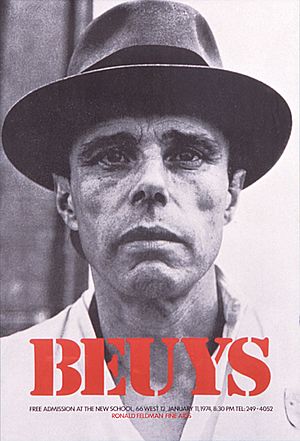Joseph Beuys facts for kids
Quick facts for kids
Joseph Beuys
|
|
|---|---|

Offset poster for Beuys' 1974 US lecture-series "Energy Plan for the Western Man", Ronald Feldman Gallery
|
|
| Born | 12 May 1921 Krefeld, Germany
|
| Died | 23 January 1986 (aged 64) Düsseldorf, Germany
|
| Nationality | German |
| Education | Kunstakademie Düsseldorf |
| Known for | Performances, sculpture, visual art, aesthetics, social philosophy |
|
Notable work
|
Fettecke |
| Signature | |
Joseph Beuys (born May 12, 1921 – died January 23, 1986) was a famous German artist. He was known for many types of art. These included Fluxus and happening art, which are kinds of performance art. He was also a sculptor, an installation artist, and a graphic artist.
Beuys was also an art theorist, meaning he thought deeply about art. He was a teacher too. His art often included sculptures, drawings, and installations. He also did many performances. Beuys shared his ideas about art and taught at universities. He was also involved in social and political activities. In 1979, a big show of his art in New York City made him even more famous. It showed he was one of the most important artists of his time.
Contents
Early Life and War Years
Joseph Beuys was born in Krefeld, Germany, on May 12, 1921. He grew up in a nearby town called Kleve. His family was very religious. From a young age, he loved art and often painted with watercolors. He saw modern art for the first time when he visited an artist's studio.
When he was 17, in 1938, he joined the Hitler Youth. Many young German men joined at that time. Before becoming an artist, he studied many subjects. He was very interested in science and history. He even studied medicine, hoping to become a doctor. But then World War II started. Beuys became a soldier in the Luftwaffe, which was the German air force. He worked as a rear gunner in a military airplane.
Becoming an Artist and Teacher
After the war, Beuys studied art at the academy in Düsseldorf. He studied there from 1946 to 1951. For most of the 1950s, he spent a lot of time drawing. In 1961, he became a professor of sculpture at the same academy.
However, he was fired in 1972. This happened because he believed his art classes should be open to everyone. He thought that anyone who wanted to learn should be able to join his classes for free. His students protested when he lost his job. Because of their protests, he was allowed to keep his studio space. But he still lost his teaching position.
Beuys strongly believed that art plays a very important role in society. His first disagreements with politicians happened when he lost his job. In the 1980s, he joined the Peace Movement. He protested against nuclear missiles in Germany. He was also one of the first members of the Green Party in the 1980s. This party focuses on environmental protection and social justice.
His Ideas About Art and Teaching
Beuys saw himself as a guide for society, like a teacher or a shaman. He believed that art could bring about big changes in the world. He was very confident that art had the power to start a revolution.
At the Düsseldorf Academy of Art, Beuys did not force his students to follow his style. He even kept his own art hidden from them. He wanted his students to explore their own ideas and talents. Beuys was strict about some things, like being on time for class. He also insisted that students take drawing classes. But he also encouraged them to set their own art goals freely. They did not have to follow a set plan.
Beuys also held open discussions called Ringgesprache (German for "ring discussions"). In these talks, he and his students discussed important topics. They talked about politics, philosophy, and the role of art in society. They also discussed democracy and the university's place in the world.
Death
Joseph Beuys died in Düsseldorf on January 23, 1986. He passed away from heart failure.
Artworks and Collections
The first artworks bought from Joseph Beuys were in 1951. They cost about €10 each in today's money. These were bought by Franz Joseph and Hans van der Grinten. They collected about 4,000 of his works. This collection is now the largest Beuys collection in the world.
After his death, the prices for Beuys's artworks changed a lot. Sometimes, his pieces did not even sell at auctions. The highest price paid for a Beuys work at an auction was $900,000. This was for a bronze sculpture called Bett (Corsett). It was sold at Sotheby's in New York in May 2008.
His artwork Schlitten (Sled), made in 1969, sold for $314,500. This happened at Phillips de Pury & Company in New York in April 2012. At the same auction, a Filzanzug (Felt Suit), from 1970, sold for $96,100.
Beuys made over 600 original "multiples" during his life. Multiples are artworks that exist in many identical copies. Large sets of these multiples are in several museums. These include the Pinakothek der Moderne in Munich, Germany. They are also at the Harvard Art Museums in Cambridge, Massachusetts. Other collections are at the Walker Art Center in Minneapolis and the Kunstmuseum Bonn, Germany. In 2006, the Broad Art Foundation in Los Angeles bought 570 of Beuys's multiples. This made it the most complete collection of his works in the United States. It is also one of the largest collections of Beuys multiples worldwide.
Images for kids
See also
 In Spanish: Joseph Beuys para niños
In Spanish: Joseph Beuys para niños







